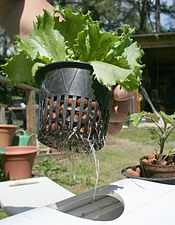Hydroculture/Horticultural aquaponics
< Hydroculture
This is a leisurely or educational resource for making or understanding aquaponic systems. The purpose is to use waste from ornamental fish to fertilize plants. This guide is for horticultural purposes with ornamental fish. Aquaponics may be used in conjunction with other forms of hydroculture.
Aquaponic specific fundamentals
Nutrients
Initially, nutrient solutions or fish establishment of the water is necessary for aquaponic gardening. New propagation tissue, like seeds and stem cuttings, can tolerate the lack of nutrients, until the levels build up from fish wastes. Aquatic animals do the work of maintaining proper plant nutrition and maintaining salt levels. Once fish are established, nutrient solutions are no longer necessary for maintaining aquaponic gardens, since fish waste provides all of the nutrients necessary. Adding nutrient solutions after this point can be detrimental to the plants, while this may not readily affect fish.
If the water is changed, the correct nutrient solution has to be compensated. Rooted or established plants may quickly die of nutrient deficiencies.
Dilute the nutrient solutions in a liter or more of water before adding to the system. The water should always be clear after application. Some initial nutrient solutions are:
- Hoagland solution
- non-hydroponic fertilizers - use 1/10 of the label dosing, with the amount of water in the container in mind
- hydroponic fertilizers - labeled directions
- sterilized soil - sterilize fertile soil in enclosed metal container for 10 minutes at 100°C, afterwards run it through a cheese cloth. (use caution with this method)
- adding less fertilizer is safer than adding too much, especially since aquatic animals immediately make up for the difference
Plant and symbiotic animal life

- Propagation material: seeds, bulbs, tubers, stem cuttings
- Fertilizer solution may be optional
- Hardy freshwater aquarium animals: goldfish, minnows, catfish algae eater, snails or shrimp (3 fish is plenty, 2 fish keep them from being lonely; goldfish seem to graze on algae)
- algae wafers, and flakes
- Aquatic life needs to be in a connected container that is open from above for health and maintenance.
Substrates
Substrate that carries a higher air to water ratio is less susceptible to moldy or rotting conditions. Subtrates with a higher air to water ratio include: expanded clay aggregate, parboiled rice hulls, growstones, wood fibre, coconut fiber, gravel or sand. Preformed clay can optionally be used to contain small seeds:[1] useful to keep them from falling through the net-pot. The clay should give good structure, then break apart when the seed sprouts.
Oxygenation
Roots must breathe oxygen. There is a limit to the amount of dissolved gasses that can be contained in water: this is where suspended roots fare better than submerged aerated roots. Aquatic plant roots do not need direct access to oxygen from their root system, because these plants are adapted to transport oxygen throughout its physiological system.
Oxygenation is also essential for aquatic animals and microorganism symbiosis. Aeration also reduces unwanted anaerobic microorganisms and conditions, such as root rot.
Oxygenation can be provided by a fountain, fine bubble aeration, by draining of water, and/or direct air access to roots.
Light
Plenty of light is required for plants to survive. A 500 lumen light bulb in addition to sunlight through a curtained window is not enough light. The light must be on a timer set to be on about 8 hours during daytime.
Projects
| Easy top-drip aquaponics system - Standalone project |
| Aquatic subsystem - Connect to hydroculture system or growbed |
| Instructional hints and tweaks - Additional instruction |
See also
- Aquaculture Project
- Botany
- Ecoversity
- Limits To Growth
- Low-cost, tropical, private food production system
- Plant physiology
- Plant propagation - The science of horticulture is useful in the understanding of aquaponics
- Sustainability
External links
| | Completion status: this resource has reached a high level of completion. |
- Aquaponics (Appropedia)
References
- ↑ "Hydroponic Lettuce". Gabriel Hoss. How its made. Discovery.
Hits this month for the page Hydroculture/Horticultural aquaponics - (Hold down CTRL key to display in separate tab in browser)

